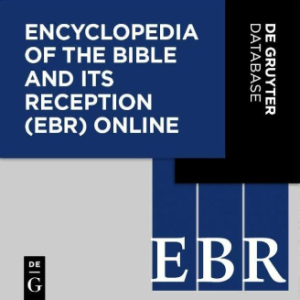The Bible is the most-read document in the world and there are many resources dedicated to its study. How is the Encyclopedia of the Bible and Its Reception different from the rest?

The online version of this title, originally published in print in 2009, includes approximately 1,500 new articles each year and updates, as necessary, older articles. It is published in English and comprises all the material found in the print edition. Certainly, EBR is an important resource for those who study the Bible, theology, and religion, but those who study a range of other disciplines, including literature, comparative studies, philosophy, history, social sciences, and art history, will be delighted by the breadth of information in this resource that relates to other areas of study. The EBR does not advocate for any specific religion and aims to assist even those who are of no faith. It offers information on how the people, places, ideas, concepts, and various themes in the Bible affected Christianity, Judaism, Islam, and other religions including secular traditions and movements. It shows how the Bible was received in literature, visual arts, music, film and dance, and other disciplines. One can find information on many prominent individuals ranging from religious artists like Caravaggio to poets like Geoffrey Chaucer and statesmen like Thomas Jefferson.
The editorial board of the EBR features seven main editors (Constance M. Furey, Peter Gemeinhardt, Joel LeMon, Thomas Römer, Jens Schröter, Barry Dov Walfish, and Eric J. Ziolkowski) who work with other smaller editors and thousands of authors in over 55 countries that contribute content to the EBR. This includes several faculty members from the Catholic University of America. The average length of articles in the EBR can vary significantly, ranging from a few hundred words to several thousand words or more in case of significant figures, topics, or themes. They typically include a Table of Contents where each section is written by a separate author based on his or her expertise and area of study (Literature, Art, Music, Film, etc.). In addition to that, each section within the articles features its own bibliography with links to search in Google Scholar included under each source. Articles also contain color illustrations, images, and plates, where applicable. It is important to note that they appear only in black and white in the print edition.
Searching EBR Online
There are a few ways of searching the EBR Online. Full Text allows for a simple keyword search across the entire content of the database with an option to use Boolean operators (AND, OR, and NOT). However, if one needs to search for specific terms within the titles of the articles, it is recommended to search by Lemma (lemma refers to the main word or form of a word as it appears in the dictionary).

Enter a desired keyword, term, or phrase and hit Search. A powerful suggested search feature provides a list of other terms and concepts as you type. For example, the word “John” will also display “John the Baptist”, “John Chrysostom”, “John Calvin”, and “Johnny Cash”. To see the entire list of articles please click on LEMMAS A-Z. One can also search by author, publication, type, bibliography, and year or browse the entire set. Of special note is the Biblical Passage search option. It allows one to search for entries with references to specific passages (Book and Chapter). For example, “Mark 16” will produce a list of articles that mention the last chapter of the Gospel of Mark. The list of results can be further refined by Publication and other search criteria. For more information about the search options please read the HELP SEARCH section.
How can students use EBR?
Students can use EBR for their term papers by selecting a particular thinker to explore how their thoughts were influenced by the Bible and progressed in their teaching, career, or life. The EBR can also assist students in choosing and exploring some topics and themes from the Scriptures, such as “love,” “hope,” or “evil,” and examining how these themes are presented in the Old Testament and New Testament, in Jewish and Christian thought, and in other religions. Additionally, students can explore how these themes were received in literature, visual arts, music, and film.
Articles can be cited and shared on Facebook, Twitter, and LinkedIn with a click of a button. They can also be downloaded as PDFs. Please note that downloaded articles are presented in the same format as they appear in the print edition and include page numbers. This feature is particularly useful when writing research papers, as page numbers must be included for any in-text citations.
Click here to search Encyclopedia of the Bible and Its Reception Online.
